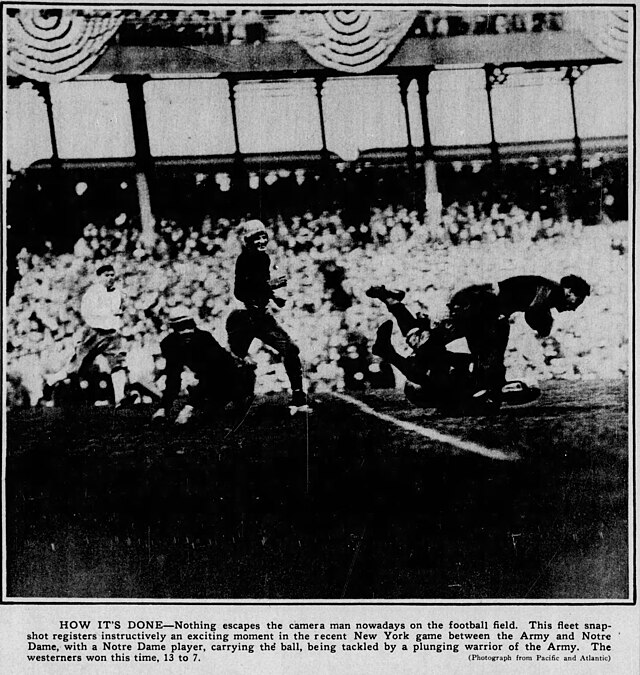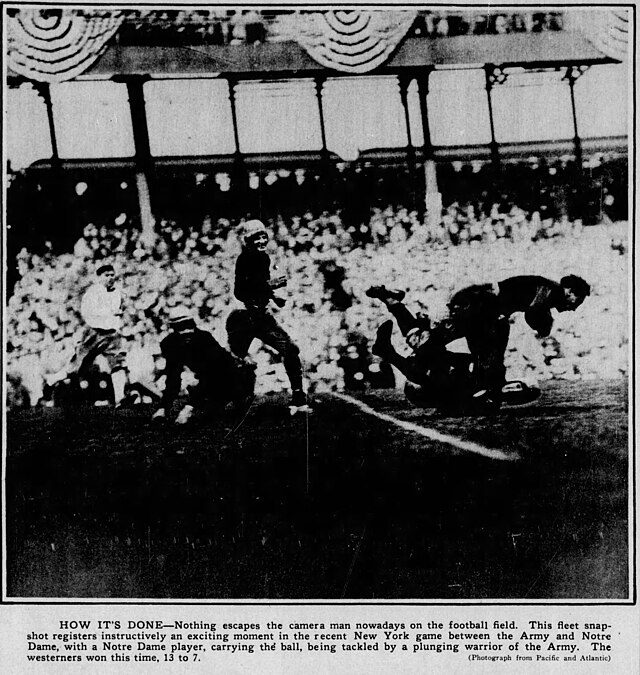The college football contest between the Notre Dame Fighting Irish and the Army Black Knights on October 18, 1924, at the Polo Grounds in New York City was a major sporting event that transcended the game itself, giving birth to arguably the most famous nickname in sports history.
The Buildup and Action
Coached by the legendary Knute Rockne, the Notre Dame squad, already undefeated early in the season, was led by its small, quick, and cohesive backfield. The game was held before approximately 55,000 spectators, who watched as Rockne employed his famous “shift” offense, which kept the Army defense confused and off-balance.
Rockne famously sent in his “Shock Troops” (second-string players) at the start of the game, letting them wear down the opposition before substituting his stars. Once the starters—the famous backfield quartet—were in, they dominated. Quarterback Harry Stuhldreher expertly orchestrated the attack, while Jim Crowley (left halfback), Don Miller (right halfback), and Elmer Layden (fullback) gashed the Army defense. Layden scored the Irish’s first touchdown on a run. A dazzling run by Crowley later secured the final margin, as Notre Dame defeated Army, 13-7.
Important Players and Coaches
- Notre Dame Coach: Knute Rockne
- The Four Horsemen (Backfield):
- Harry Stuhldreher (QB)
- Don Miller (RHB)
- Jim Crowley (LHB)
- Elmer Layden (FB)
- The Seven Mules (Offensive Line): A key group that included center Adam Walsh (who played with two broken hands), often overshadowed by the backfield.

The Significance: The Four Horsemen
While the 13-7 victory was pivotal in Notre Dame’s undefeated season—which culminated in their first consensus National Championship—the game’s lasting significance came from the press box.
During halftime, student publicity aide George Strickler suggested to sportswriters that the Irish backfield resembled the “Four Horsemen” from the popular Rudolph Valentino film, The Four Horsemen of the Apocalypse.
Sportswriter Grantland Rice, the dean of American sports journalism, immortalized the comment in his column for the New York Herald Tribune the next day with the most famous opening passage in sports history:
“Outlined against a blue-gray October sky, the Four Horsemen rode again. In dramatic lore they are known as Famine, Pestilence, Destruction and Death. These are only aliases. Their real names are Stuhldreher, Miller, Crowley and Layden.”
This poetic description instantly turned the four players into college football icons, cementing their status as a legendary unit and elevating Notre Dame to a national brand.



[…] The Birth of a Legend: Notre Dame vs. Army at the Polo Grounds, October 18, 1924 […]